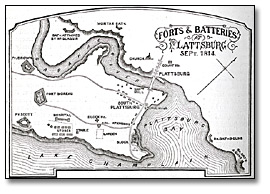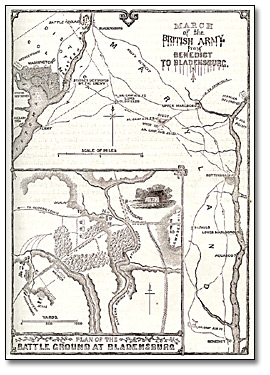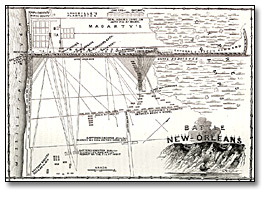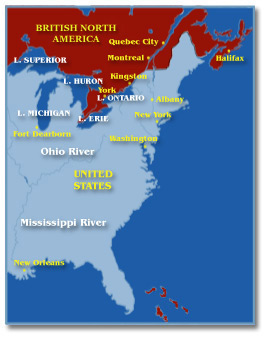
Table of Contents
Home | Setting the Stage | Battlegrounds | Militia and Civilian Life
Prisoners of War | Loyalty and Treason | The War Ends
After the War | Chronology | Soldiering in Canada
Important Figures | Important Places| Glossary
Sources | Links | The Making of a Virtual Exhibit
|
||
|
|
||
A more vigorous attempt was made in the fall of 1813, but the American army retreated after the Battle of Châteauguay just south of Montreal. Colonel de Salaberry's clever use of terrain convinced the Americans that they were facing overwhelming numbers. The Royal Navy and rugged terrain protected Quebec City and the Maritime Provinces from any serious threat of invasion from the United States. In the first year of the war the United States navy won a number of small ship actions in the Atlantic which provided the same boost to morale in the republic as arose in Upper Canada after the capture of Detroit and the Battle of Queenston Heights. |
![Watercolour: Montreal, Quebec [ca. 1792] Watercolour: Montreal, Quebec [ca. 1792]](pics/6347_montreal_simcoe_270.jpg) Click
to see a larger image (60K) |
|
| [ Return to top
of page ] |
||
|
||
As both sides were already trying to negotiate a treaty of peace, the objective would be to capture territory and damage American interests to offset any territories in Upper Canada held by the United States at the conclusion of the conflict. |
||
How was the power to be brought to bear against the United States? Upper Canada remained a difficult place to mount military operations. It was decided to launch a three-pronged attack on the United States that would take advantage of their relative strengths. |
||
| [ Return to top
of page ] |
||
|
||
|
|
||
 |
The expedition ended in failure when General Prevost, with more than 12,000 troops, withdrew on the defeat of his war vessels at the Battle of Lake Champlain. Click
to see a larger image (123K)
|
|
| [ Return to top
of page ] |
||
 |
||
|
|
||
Parts of Maine were occupied and annexed. Washington was attacked, and at the Battle of Bladensburg American forces were defeated. This allowed the British to occupy the capital and destroy many of the public buildings in retaliation for the destruction of York in 1813. The attempt to capture the naval facilities at Baltimore a short time later was defeated when the bombardment from the Royal Navy failed to force the surrender of Fort McHenry. The Star Spangled Banner commemorates this event. Admiral Sir Alexander Cochrane sustained a series of raids against American coastal communities and shipping throughout the summer of 1814 to put further pressure on the American authorities. Click
to see a larger image (272K)
|
 | |
|
||
| [ Return to top
of page ] |
||
 |
||
|
||
 | A poorly executed attack led to a severe defeat of the British forces under General Packenham at the Battle of New Orleans in January 1815. This American victory played a role in the rise of their commander, Andrew Jackson, to the Presidency in the 1830s. Click
to see a larger image (191K)
|
|
| [ Return to top
of page ] |
||

 everal
American offensives were aimed at Lower Canada with the intention
of cutting the St. Lawrence supply line by capturing Montreal. Invasions
in the fall of 1812 and spring of 1814 barely crossed the borders
before turning back.
everal
American offensives were aimed at Lower Canada with the intention
of cutting the St. Lawrence supply line by capturing Montreal. Invasions
in the fall of 1812 and spring of 1814 barely crossed the borders
before turning back. 
 814
saw a shift in the relative power of the two protagonists in the
Western Hemisphere. With the defeat of
814
saw a shift in the relative power of the two protagonists in the
Western Hemisphere. With the defeat of 

 lattsburgh
served as the main American naval base on Lake Champlain in New
York State. It was hoped that destroying the American fleet on the lake
and capturing the base could be used to bargain against the similar
British loss on Lake Erie the previous year.
lattsburgh
served as the main American naval base on Lake Champlain in New
York State. It was hoped that destroying the American fleet on the lake
and capturing the base could be used to bargain against the similar
British loss on Lake Erie the previous year.  he
Royal Navy was able to establish a blockade on the Atlantic coast
of the United States that placed major restrictions on their ability
to trade with other nations. It was also decided to make use of
the mobility provided by the navy to launch raids on the coast and
occupy territory to be used in negotiations for revisions to the
border in the final settlement.
he
Royal Navy was able to establish a blockade on the Atlantic coast
of the United States that placed major restrictions on their ability
to trade with other nations. It was also decided to make use of
the mobility provided by the navy to launch raids on the coast and
occupy territory to be used in negotiations for revisions to the
border in the final settlement.